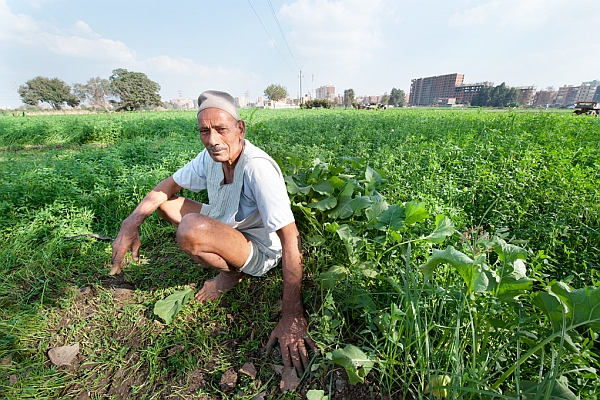By Carolyn Fry
Agriculture is primarily perceived as a rural occupation that takes place far from the urban centres that consume many of its products. However, with more than half the world’s population now living in cities, farming is increasingly being practised within and around conurbations. The first-ever global assessment of the extent of urban and peri-urban agriculture, conducted jointly by IWMI (under the CGIAR Research Program on Water, Land and Ecosystems [WLE]), the University of California-Berkeley and Stanford University, found that land equivalent in extent to the size of the European Union is now being farmed within 20 kilometres of cities. Some 67 million hectares of this farmland, around 14%, comprises open spaces lying within urban heartlands.

The release this month of the book Cities and agriculture: Developing resilient urban food systems, is therefore timely. Published by Earthscan and edited by Henk de Zeeuw, Senior Advisor at the Resource Centres on Urban Agriculture and Food Security (RUAF) Foundation, and Pay Drechsel, Principal Researcher at IWMI, the book reviews the state-of-the-art of urban and peri-urban agriculture.
International experts present their findings on everything from the inclusion of agriculture in urban planning, to the role of women in developing urban food strategies, and the safe use of organic wastes and wastewater within food production.
“Many different academic disciplines are working on urban agriculture, from experts in architecture to those concerned with climate change or human health,” explains Drechsel. “The purpose of the book was to summarize the growing body of literature on the subject and to make it available in a one-stop-shop.”
Cropping Havana
One encouraging trend is the way that people in different contexts around the world are taking the opportunity to improve their food systems.
There are many benefits to urban agriculture, not least its contribution to humanity’s food supply. Large inner-city areas now supply leafy vegetables that cannot be transported over longer distances. These boost the nutrition of citizens, as well as enabling farmers to generate higher incomes than they would in rural areas. Cuba was among the first countries to formalize urban farming, having been forced to grow more food after being cut off from trade with the Soviet Bloc in 1989. Its success is well-documented; today more than half of Havana’s fresh produce is grown within the capital. Meanwhile, in many African cities, at least 60% of all perishable vegetables comes from inner-urban farms.
As well as providing nutritious food, urban farming has a greening effect within cities; provides jobs for migrants from rural areas; and, through shorter food chains, also supports lower carbon footprints. Being able to feed citizens even when established rural food supply chains become compromised strengthens cities’ resilience, a point highlighted by HRH The Prince of Wales in his foreword to the Cities and agriculture book. “One encouraging trend is the way that people in different contexts around the world are taking the opportunity to improve their food systems,” he writes. “This is being done through actions at the city level, and strengthening the linkages between rural areas and their urban hinterlands in ways that help reduce some of the negative consequences arising from the current conventional approach.”
In the developing world, urban farming is still spreading informally rather than through planned initiatives. Economic migrants leaving rural parts soon realize that they can earn more money in urban areas from doing what they know – growing crops – than by competing on the open jobs market. They simply farm any available plot, favoring areas with water available for growing crops during the dry season, when market prices peak. A disadvantage of such unplanned urban farming is that crops may become contaminated by polluted soils or water, or toxic traffic emissions. This presents a risk to consumers.
Farming goes to town
The flagship will look at food chains that are vulnerable to disasters.
With many cities in low-income countries facing water shortages, reusing wastewater safely appears, however, to be the only way to provide sufficient water for all urban needs, including agriculture. The United Nations Sustainable Development Goals should help to ensure this is done without negatively affecting health. For example, one of the Goal 6 targets covering water use strives towards ‘substantially increasing recycling and safe reuse’; Goal 11, concerned with cities, calls for ‘resource efficiency’; and one of the Goal 12 targets is to ‘substantially reduce waste generation through prevention, reduction, recycling and reuse’. “We need to find ways to safely use wastewater for urban farming so freshwater goes to higher quality needs, such as drinking water,” explains Drechsel.
New farming systems established in response to urban demands are becoming increasingly significant, so it is likely that complex connections between rural and urban areas will, in future, increasingly influence global food security. Peri-urban and urban food systems are particularly opportune for enhancing smallholder sustainable agricultural intensification – one of the key goals of CGIAR. IWMI therefore plans to introduce a flagship research strand to investigate these farming systems and urban-rural agricultural linkages, to be carried out under the next generation CGIAR research programmes starting in 2017.
“The flagship will look at rural-urban food chains that are vulnerable to disasters, such as droughts or floods, as these need to be examined carefully when developing urban resilience strategies,” says Drechsel. “We will also study the affect of urban pollution on peri-urban ecosystems, linking stakeholders across administrative and sectoral boundaries while exploring business options for turning urban waste into a resource. To achieve this we will team up with a great network of partners, many who contributed to the new book, to ensure the CGIAR remains at the forefront of agricultural research as the urban millennium gathers pace.”
Cities and Agriculture: Developing Resilient Urban Food Systems
Edited by Henk de Zeeuw, Pay Drechsel
Foreword by HRH The Prince of Wales
https://www.routledge.com/products/9781138860599
This work is supported by the CGIAR Research Program on Water Land and Ecosystems

